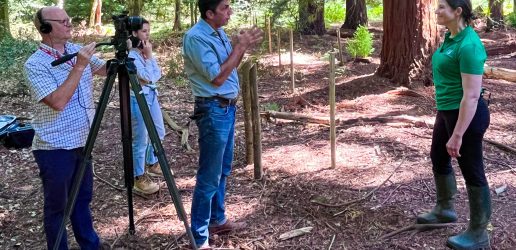On Friday 17 January, the government’s Chief Plant Health Officer, Nicola Spence, accompanied by Forest Research’s Chris Reynolds, visited the project to plant one of the last trees in the Ash Archive, a major step towards maintaining and restoring ash in the British landscape. The ceremony marked the beginning of the International Year of Plant Health – a global initiative to raise awareness on the importance of healthy plants and trees to protecting nature, the environment and boosting economic development.
Three thousand trees have been planted in Hampshire in the UK’s first Ash Archive, established using £1.9 million of government funding and the culmination of projects spanning 5 years to identify ash with a high tolerance to the disease. It is intended that it will provide the basis for a breeding programme of tolerant ash over time and will enable the development of orchards producing commercially available seed.
Nicola Spence, Defra Chief Plant Health Officer, said:
“I’m delighted to acknowledge the successes of the Ash Archive project and welcome the International Year of Plant Health by planting an ash dieback-tolerant tree. This is a damaging disease to our native ash trees as well as our timber industry. That’s why since 2012, the Government has invested more than £6m into ash dieback research and £4.5m to strengthen border security. As it stands, we currently have some of the most stringent import controls in Europe. Alongside these measures it is vital that we continue to work on securing our ash trees for the future, so I’m thrilled to see the progress that has been made with the Ash Archive and look forward to the advances we can make with breeding these trees further.”
Lord Gardiner, Biosecurity Minister, said:
“The International Year of Plant Health is a timely reminder of the importance of our natural environment and the action that is required, from Government and beyond, to protect our island’s rich heritage of trees and plants from dangerous diseases such as ash dieback. That is why we are committed to funding innovation in this field. We look forward to continuing our work with Future Trees Trust and Forest Research to develop a genetic collection of trees that will contribute to keeping the iconic ash tree prevalent in our landscapes.”
As part of the Government Ash Research Strategy, Defra funded two projects which studied ash trees as they grew to identify those exhibiting a high degree of tolerance to ash dieback. These were than grafted on to ash rootstocks and grown in nurseries before being planted to form the archive. Working in collaboration with Future Trees Trust, Forest Research, Forestry England, Kew Gardens and Fera, the trees will now be used for further scientific research into the disease.
The next steps for the project are to monitor tolerance levels of the trees under real-world conditions and continue to refine the archive by removing any trees that are damaged by the disease and replacing them with newly-identified tolerant trees from the wider countryside and other trials.
Future Trees Trust Head of Research, Jo Clark, said:
“It’s exciting to finally see these trees planted. They have been selected from across Britain and we will continue to monitor them over the next five years to ensure we have the most tolerant individuals with which to commence a new breeding programme for ash, thereby retaining ash as a tree for timber purposes as well as biodiversity.”
Cumbria-based land managers and local landscape decision-makers sought for research about ticks.

Dr Gail Atkinson was interviewed by the BBC’s Climate Editor, Justin Rowlatt, as part of a news item on climate change and the launch of latest Met Office State of the UK Climate Report.

The British Woodlands Survey, 2025, which focuses on resilience launches.
Cumbria-based land managers and local landscape decision-makers sought for research about ticks.

Dr Gail Atkinson was interviewed by the BBC’s Climate Editor, Justin Rowlatt, as part of a news item on climate change and the launch of latest Met Office State of the UK Climate Report.

The British Woodlands Survey, 2025, which focuses on resilience launches.